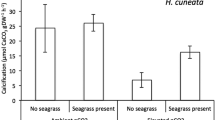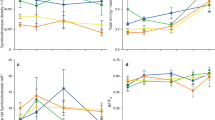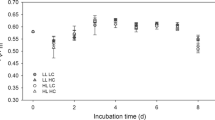Abstract
Ocean warming and acidification are co-occurring stressors likely to affect marine biota through climate-driven change to the ocean. We investigated the effects of increased temperature and lowered pH, solely and in combination, on the growth of the endemic Australian bryozoan, Celleporaria nodulosa. Two temperatures and three pH levels were fully crossed in experimental treatments performed in winter 2008 (August) and summer 2009 (February/March). Fragments of C. nodulosa colonies (clones) were collected from Coffs Harbour, NSW, Australia, (30°18′S, 153°09′E) and elongation of colonies was assessed periodically over a 12-day incubation period. Lowered pH in winter significantly decreased growth. Elevated temperatures during the summer significantly impeded the growth of bryozoan colonies, possibly masking the effect of ocean acidification and discovering a maximal thermal tolerance at around 27 °C for C. nodulosa. The effects of decreased pH and increased temperature may be seasonally dependent and particularly acute during the summer months. Thermal stress may in fact be the initial stressor before ocean acidification, negatively affecting organisms in such a way that they are unable to survive before feeling the effects of ocean acidification.


Similar content being viewed by others
References
Albright R, Langdon C (2011) Ocean acidification impacts multiple early life history processes of the Caribbean coral Porites astreoides. Glob Change Biol 17:2478–2487
Albright R, Mason B, Miller M, Langdon C (2010) Ocean acidification compromises recruitment success of the threatened Caribbean coral Acropora palmata. P Natl Acad Sci USA 107:20400–20404
Amui-Vedel AM, Hayward PJ, Porter JS (2007) Zooid size and growth rate of the bryozoan Cryptosula pallasiana Moll in relation to temperature, in culture and in its natural environment. J Exp Mar Biol Ecol 353:1–12
Anlauf H, D’Croz L, O’Dea A (2011) A corrosive concoction: the combined effects of ocean warming and acidification on the early growth of a stony coral are multiplicative. J Exp Mar Biol Ecol 397:13–20
Atkinson D, Morley SA, Hughes RN (2006) From cells to colonies: at what levels of body organization does the ‘temperature-size rule’ apply? Evol Dev 8:202–214
Brakefield PM, Kesbeke F (1997) Genotype-environment interactions for insect growth in constant and fluctuating temperature regimes. Proc R Soc B Biol Sci 264:717–723
Brennand HS, Soars N, Dworjanyn SA, Davis AR, Byrne M (2010) Impact of ocean warming and ocean acidification on larval development and calcification in the sea urchin Tripneustes gratilla. PLoS One 5:e11372
Byrne M (2011) Impact of ocean warming and ocean acidification on marine invertebrate life history stages: vulnerabilities and potential for persistence in a changing ocean. Ocean Mar Biol Ann Rev 49(49):1–42
Byrne M, Ho M, Selvakumaraswamy P, Nguyen HD, Dworjanyn SA, Davis AR (2009) Temperature, but not pH, compromises sea urchin fertilization and early development under near-future climate change scenarios. Proc R Soc B 276:1883–1888
Byrne M, Ho M, Wong E, Soars NA, Selvakumaraswamy P, Shepard-Brennand H, Dworjanyn SA, Davis AR (2011) Unshelled abalone and corrupted urchins: development of marine calcifiers in a changing ocean. Proc R Soc Lond Ser B Biol Sci 278:2376–2383
Caldeira K, Wickett ME (2003) Oceanography: anthropogenic carbon and ocean pH. Nature 425:365
De’ath G, Lough JM, Fabricius KE (2009) Declining coral calcification on the great barrier reef. Science 323:116–119
Deutsch CA, Tewksbury JJ, Huey RB, Sheldon KS, Ghalambor CK, Haak DC, Martin PR (2008) Impacts of climate warming on terrestrial ectotherms across latitude. P Natl Acad Sci USA 105:6668–6672
Dickson AG, Millero FJ (1987) A comparison of the equilibrium-contrasts for the dissociation of carbonic-acid in seawater media. Deep Sea Res 34:1733–1743
Duckworth AR, Battershill CN, Schiel DR (2004) Effects of depth and water flow on gowth, survival and bioactivity of two temperate sponges cultured in different seasons. Aquaculture 242:237–250
Fabry VJ, Seibel BA, Feely RA, Orr JC (2008) Impacts of ocean acidification on marine fauna and ecosystem processes. ICES J Mar Sci 65:414–432
Feely RA, Sabine CL, Lee K, Berelson W, Kleypas J, Fabry VJ, Millero FJ (2004) Impact of anthropogenic CO2 on the CaCO3 system in the oceans. Science 305:362–366
Findlay HS, Wood HL, Kendall MA, Spicer JI, Twitchett RJ, Widdicombe S (2009) Calcification, a physiological process to be considered in the context of the whole organism. Biogeosci Discuss 6:2267–2284
Flint J, Mackay TFC (2009) Genetic architecture of quantitative traits in mice, flies, and humans. Genome Res 19:723–733
Gazeau F, Quiblier C, Jansen JM, Gattuso JP, Middelburg JJ, Heip CHR (2007) Impact of elevated CO2 on shellfish calcification. Geophys Res Lett 34:5
Gooding RA, Harley CDG, Tang E (2009) Elevated water temperature and carbon dioxide concentration increase the growth of a keystone echinoderm. Proc Natl Acad Sci USA 106:9316–9321
Guinotte JM, Fabry VJ (2008) Ocean acidification and its potential effects on marine ecosystems. Ann NY Acad Sci 1134:320–342
Haworth CMA, Plomin R (2010) Quantitative genetics in the era of molecular genetics: learning abilities and disabilities as an example. J Am Acad Child Psychiatr 49:783–793
Hoegh-Guldberg O, Mumby PJ, Hooten AJ, Steneck RS, Greenfield P, Gomez E, Harvell CD, Sale PF, Edwards AJ, Caldeira K, Knowlton N, Eakin CM, Iglesias-Prieto R, Muthiga N, Bradbury RH, Dubi A, Hatziolos ME (2007) Coral reefs under rapid climate change and ocean acidification. Science 318:1737–1742
Hughes DJ (1989) Variation in reproductive strategy among clones of the bryozoan Celleporella hyalina. Ecol Monogr 59:387–403
Hughes RN, Manriquez PH, Bishop JDD, Burrows MT (2003) Stress promotes maleness in hermaphroditic modular animals. Proc Natl Acad Sci USA 100:10326–10330
Hughes AR, Inouye BD, Johnson MTJ, Underwood N, Vellend M (2008) Ecological consequences of genetic diversity. Ecol Lett 11:609–623
Hunter E, Hughes RN (1995) Environmental and genetic components of variation in sexual allocationby and epialgal bryozoan. Mar Ecol Prog Ser 120:193–201
Hutchins DA, Stupakoff I, Fisher NS (1996) Temperature effects on accumulation and retention of radionuclides in the sea star, Asterias forbesi: implications for contaminated northern waters. Mar Biol 125:701–706
IPCC (2007) Climate change 2007: the fourth assessment report of the intergovernmental panel on climate change (IPCC). Cambridge University Press, Cambridge
Kleypas JA, Buddemeier RW, Archer D, Gattuso JP, Langdon C, Opdyke BN (1999) Geochemical consequences of increased atmospheric carbon dioxide on coral reefs. Science 284:118–120
Kurihara H (2008) Effects of CO2-driven ocean acidification on the early developmental stages of invertebrates. Mar Ecol Prog Ser 373:275–284
Lacoue-Labarthe T, Martin S, Oberhansli F, Teyssie JL, Jeffree R, Gattuso JP, Bustamante P (2012) Temperature and pCO(2) effect on the bioaccumulation of radionuclides and trace elements in the eggs of the common cuttlefish, Sepia officinalis. J Exp Mar Biol Ecol 413:45–49
Langer G, Nehrke G, Probert I, Ly J, Ziveri P (2009) Strain-specific responses of Emiliania huxleyi to changing seawater carbonate chemistry. Biogeosci Discuss 6:2637–2646
Lisbjerg D, Petersen JK (2001) Feeding activity, retention efficiency, and effects of temperature and particle concentration on clearance rate in the marine bryozoan Electra crustulenta. Mar Ecol Prog Ser 215:133–141
Lombardi C, Cocito S, Occhipinti-Ambrogi A, Hiscock K (2006) The influence of seawater temperature on zooid size and growth rate in Pentapora fascialis (Bryozoa: Cheilostomata). Mar Biol 149:1103–1109
Lombardi C, Cocito S, Hiscock K, Occhipinti-Ambrogi A, Setti M, Taylor PD (2008) Influence of seawater temperature on growth bands, mineralogy and carbonate production in a bioconstructional bryozoan. Facies 54:333–342
Lombardi C, Rodolfo-Metalpa R, Cocito S, Gambi MC, Taylor PD (2011) Structural and geochemical alterations in the Mg calcite bryozoan Myriapora truncata under elevated seawater pCO(2) simulating ocean acidification. Mar Ecol Evol Perspect 32:211–221
Love JW, Rees BB (2002) Seasonal differences in hypoxia tolerance in gulf killifish, Fundulus grandis (Fundulidae). Environ Biol Fishes 63:103–115
Martin S, Gattuso J-P (2009) Response of mediterranean coralline algae to ocean acidification and elevated temperature. Glob Change Biol 15:2089–2100
Mehrbach C, Culberso CH, Hawley JE, Pytkowic RM (1973) Measurement of apparent dissociation-constants of carbonic-acid in seawater at atmospheric-pressure. Limnol Oceanogr 18:897–907
O’Dea A, Okamura B (1999) Influence of seasonal variation in temperature, salinity and food availability on module size and colony growth of the estuarine bryozoan Conopeum seurati. Mar Biol 135:581–588
Orr JC, Fabry VJ, Aumont O, Bopp L, Doney SC, Feely RA, Gnanadesikan A, Gruber N, Ishida A, Joos F, Key RM, Lindsay K, Maier-Reimer E, Matear R, Monfray P, Mouchet A, Najjar RG, Plattner GK, Rodgers KB, Sabine CL, Sarmiento JL, Schlitzer R, Slater RD, Totterdell IJ, Weirig MF, Yamanaka Y, Yool A (2005) Anthropogenic ocean acidification over the twenty-first century and its impact on calcifying organisms. Nature 437:681–686
Pandolfi JM, Connolly SR, Marshall DJ, Cohen AL (2011) Projecting coral reef futures under global warming and ocean acidification. Science 333:418–422
Parker LM, Ross PM, O’Connor WA (2009) The effect of ocean acidification and temperature on the fertilization and embryonic development of the Sydney rock oyster Saccostrea glomerata (Gould 1850). Glob Change Biol 15:2123–2136
Piola RF, Johnston EL (2006) Differential resistance to extended copper exposure in four introduced bryozoans. Mar Ecol Prog Ser 311:103–114
Pistevos JCA, Calosi P, Widdicombe S, Bishop JDD (2011) Will variation among genetic individuals influence species responses to global climate change? Oikos 120:675–689
Poloczanska ES, Babcock RC, Butler A, Hobday A, Hoegh-Guldberg O, Kunz TJ, Matear R, Milton DA, Okey TA, Richardson AJ (2007) Climate change and Australian marine life. Oceanogr Mar Biol 45:407–478
Portner HO, Langenbuch M, Michaelidis B (2005) Synergistic effects of temperature extremes, hypoxia, and increases in CO2 on marine animals: from Earth history to global change. J Geophys Res 110:C09S10. doi:10.1029/2004JC002561
Price TD, Qvarnstrom A, Irwin DE (2003) The role of phenotypic plasticity in driving genetic evolution. Proc R Soc Lond Ser B Biol Sci 270:1433–1440
Przeslawski R, Ahyong S, Byrne M, Worheide G, Hutchings P (2008) Beyond corals and fish: the effects of climate change on noncoral benthic invertebrates of tropical reefs. Glob Change Biol 14:2773–2795
Riisgard HU, Manriquez P (1997) Filter-feeding in fifteen marine ectoprocts (Bryozoa): particle capture and water pumping. Mar Ecol-Prog Ser 154:223–239
Rodolfo-Metalpa R, Lombardi C, Cocito S, Hall-Spencer JM, Gambi MC (2010) Effects of ocean acidification and high temperatures on the bryozoan Myriapora truncata at natural CO2 vents. Mar Ecol 31:447–456
Sabine CL, Feely RA, Gruber N, Key RM, Lee K, Bullister JL, Wanninkhof R, Wong CS, Wallace DWR, Tilbrook B, Millero FJ, Peng T-H, Kozyr A, Ono T, Rios AF (2004) The oceanic sink for anthropogenic CO2. Science 305:367–371
Smit B, Wandel J (2006) Adaptation, adaptive capacity and vulnerability. Global Environ Change 16:282–292
Smith AM (2009) Bryozoans as southern sentinels of ocean acidification: a major role for a minor phylum. Mar Freshw Res 60:475–482
Sunday JM, Crim RN, Harley CDG, Hart MW (2011) Quantifying rates of evolutionary adaptation in response to ocean acidification. PLoS One 6(8):e22881. doi:10.1371/journal.pone.0022881
Suwa R, Nakamura M, Morita M, Shimada K, Iguchi A, Sakai K, Suzuki A (2010) Effects of acidified seawater on early life stages of scleractinian corals (Genus Acropora). Fish Sci 76:93–99
Todd PA, Ladle RJ, Lewin-Koh NJI, Chou LM (2004) Genotype x environment interactions in transplanted clones of the massive corals Favia speciosa and Diploastrea heliopora. Mar Ecol Prog Ser 271:167–182
Todgham AE, Hofmann GE (2009) Transcriptomic response of sea urchin larvae Strongylocentrotus purpuratus to CO2-driven seawater acidification. J Exp Biol 212:2579–2594
Toro JE, Alcapan AC, Ojeda JA, Vergara AM (2004) Selection response for growth rate (shell height and live weight) in the chilean blue mussel (Mytilus chilensis hupe 1854). J Shellfish Res 23:753–757
Underwood AJ (1997) Experiments in ecology: their logical design and interpretation using analysis of variance. Cambridge University Press, Cambridge
Underwood A, Chapman M (1998) GMAV5 for Windows. Institute of Marine Ecology, Sydney, Australia
Veron JEN, Hoegh-Guldberg O, Lenton TM, Lough JM, Obura DO, Pearce-Kelly P, Sheppard CRC, Spalding M, Stafford-Smith MG, Rogers AD (2009) The coral reef crisis: the critical importance of < 350 ppm CO2. Mar Pollut Bull 58:1428–1436
Vezina AF, Hoegh-Guldberg O (2008) Effects of ocean acidification on marine ecosystems introduction. Mar Ecol Prog Ser 373:199–201
Winston JE (2010) Life in the colonies: learning the alien ways of colonial organisms. Integr Comp Biol 50:919–933
Wong GTF (1979) Alkalinity and pH in the southern Chesapeake bay and the James River estuary. Limnol Oceanogr 24:970–977
Wood HL, Spicer JI, Widdicombe S (2008) Ocean acidification may increase calcification rates, but at a cost. Proc R Soc Lond Ser B Biol Sci 275:1767–1773
Acknowledgments
We would like to thank the team at the National Marine Science Centre (Coffs Harbour, Australia) for their assistance in experimental system set up and maintenance. Research was funded by an Australian Research Council Fellowship and Grants awarded to ELJ and MB.
Author information
Authors and Affiliations
Corresponding author
Additional information
Communicated by U. Sommer.
Rights and permissions
About this article
Cite this article
Durrant, H.M.S., Clark, G.F., Dworjanyn, S.A. et al. Seasonal variation in the effects of ocean warming and acidification on a native bryozoan, Celleporaria nodulosa . Mar Biol 160, 1903–1911 (2013). https://doi.org/10.1007/s00227-012-2008-4
Received:
Accepted:
Published:
Issue Date:
DOI: https://doi.org/10.1007/s00227-012-2008-4




